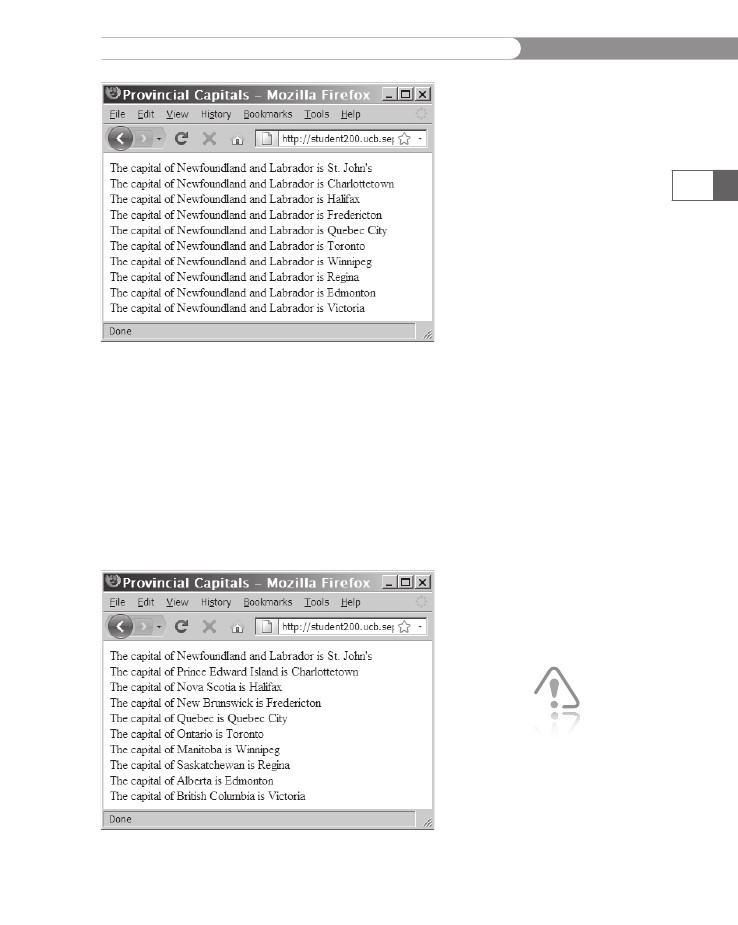
- •Initializing with Constructor Functions . . . . .
- •Into a Web page as a separate section. Although JavaScript code can
- •Is that standard php script delimiters are guaranteed to be available
- •In the block. Any text or lines between the opening /* characters and
- •2.7541 Are not integers; they are floating-point numbers. A floating-
- •Value 300
- •Is a value of 2.5, because 6 goes into 15 exactly 2.5 times. But if you
- •IsEven.Php.
- •Ing example,
- •Ing curly brace is on its own line following the function statements.
- •In php 3 and earlier, it was necessary to put a function definition
- •Is called an iteration. When the conditional expression evaluates
- •Including Files
- •13. Close your Web browser window.
- •Including Files
- •In php, you can also use two operators to combine strings. The first
- •Xhtml source code gen-
- •Input. Php provides several functions for manipulating the case of a
- •Is uppercase. If you need the reverse of ucfirst(), the lcfirst()
- •In some situations, you will need to find and extract characters and
- •Information Interchange, or ascii, which are numeric represen-
- •In comparison, the following preg_match() function returns a value
- •In the pattern is optional. The following code demonstrates how to
- •Values; any strings you validate against a regular expression must
- •Value of 1 because the top-level domain contains a valid value of .Com.
- •Is submitted using the “post” method, the form data is embedded in
- •Validating String Data
- •Xhtml tags or character entities. The message field is a text string
- •Value of the header element. For example:
- •Xhtml code within a php script section.
- •Is typically the person who created the resource. Otherwise, the net-
- •If even a single character of the Web page is sent prior to sending
- •Variables to the file_put_contents() function.
- •Xhtml hyperlink. To download a file from outside the xhtml
- •If...Else statement to display the appropriate version of the mes-
- •Iterating Through an Array
- •Iterating Through an Array
- •In Chapter 2, you learned how to use a foreach statement to iterate
- •Iterating Through an Array
- •Iterating Through an Array
- •In comparison, the following code declares and initializes
- •If ((!file_exists("MessageBoard/messages.Txt"))
- •Values from the array to create a thumbnail gallery of images in which
- •Introduction to Databases
- •Including php, allow you to create Web pages that can read and write
- •Introduction to Databases
- •Information that can be organized into ordered sets of data, and
- •Information. Each recipe in a recipe database, for instance, is a single
- •Introduction to Databases
- •Index, which identifies records in a database to make retrievals and
- •In a single table. However, you might want to break the information
- •Into multiple tables to better organize it into logical sets. Another
- •Information in one of the tables confidential and accessible only by
- •Is the employee information table from Figure 7-1. The related table
- •Is a payroll table that contains confidential salary and compensation
- •Information. Notice that each table contains an identical number of
- •Introduction to Databases
- •Introduction to Databases
- •In a junction
- •Introduction to Databases
- •In a relational format is called a relational database management
- •Is a standard data manipulation language among many dbmSs.
- •Into the query area at the top of the screen or by dragging tables and
- •It is important to understand that even though many dbmSs sup-
- •Introduction to Databases
- •If you ever
- •Is. In comparison, the bigint data type stores integer values between
- •5 Rows in set (0.00 sec)
- •Int);[enter ]
- •Important, these two tabs can cause you to lose all of the data in the
- •Internet Explorer to export the table, click the Save button in the File
- •Ifies the table being changed and the change to make.
- •It easier for you to write php code that can be used with a variety of
- •Information about queries that match one of the following formats:
- •Various types of actions, depending on the type of query.
- •Include fields for the date and time of the flight, flight number, and
- •In the ChineseZodiac folder and upload the file to the server. Open
- •Including white space,
- •Information on a Web server. When you start a new session, the
- •Introduction to Object-Oriented Programming
- •Introduction to Object-Oriented
- •Variables associated with an object are called properties or attributes.
- •In the Loan object example, a function that calculates the number of
- •Introduction to Object-Oriented Programming
- •Introduction to Object-Oriented Programming
- •Include instances of objects inherit the object’s functionality.
- •In this chapter, you will create the Web site for an online order form
- •In an online store application. The application includes information
- •Ity of building a working online store. Online store classes are very
- •Information and products. The OnlineStore class requires that store
- •Information is stored in a table containing six fields: storeId, name,
- •Information. Instead, the class simply uses session iDs to keep track
- •Variable and function as necessary, without bothering with all this
- •In a class
- •Is developed. Imagine what would happen if Microsoft distributed
- •Ing class is invalid because it does not include an access specifier:
- •If they will not be supported by future xhtml versions or are not
- •Xhtml standards. To review the guide of current w3c css specifi-
- •Information to remind yourself or others of what the code is doing. A
- •Xhtml document to the external style sheet. This link informa-
- •If you select Apache from the WampServer menu and select Service
- •Ing code uses the number_format() function to add comma separa-
- •In data that a user submits to a php script.
- •Value of “On” and the display_startup_errors directive is assigned
- •Instead. By looking at the source code, you could see that the value of
- •Ing engine can even help locate logic errors.
- •In Chapter 8, along with the equivalent mssql_* functions, where
- •Inline styles, 632
- •Xhtml, 620–635 (continued)
5.
If
the statement list[]
= 'B'; immediately
follows the
statement
list[25]
= 'A';,
what is the array index for the
element
whose value is ‘B’?
323
through
the elements in an array. As a refresher, the following exam-
ple
declares and initializes an indexed array named $DaysOfWeek[]
and
uses a foreach
statement
to iterate through it:
$DaysOfWeek
= array("Sunday", "Monday",
"Tuesday",
"Wednesday", "Thursday",Iterating Through an Array
Iterating Through an Array
In Chapter 2, you learned how to use a foreach statement to iterate
"Friday", "Saturday");
foreach ($DaysOfWeek as $Day) {
echo "<p>$Day</p>\n";
}
Even though a foreach statement allows you to loop through the
elements of an array, it does not change the position of the internal
array pointer, a special type of variable that refers to the currently
selected element in an array. The internal array pointer is a way of
keeping track of which element you are working with in an array. Use
the functions listed in Table 6-1 to iterate through an array with the
internal array pointer.
Function
each(array)
Description
Returns the key and value of the current array element
and moves the internal array pointer to the next
element
Moves the internal array pointer to the last element
Returns the key of the current array element
Moves the internal array pointer to the next element
Moves the internal array pointer to the previous element
Resets the internal array pointer to the first element
current(array) Returns the current array element
end(array)
key(array)
next(array)
prev(array)
reset(array)
Table 6-1
Array pointer iteration functions
As a simple example of how to use the iteration functions, the
next() function in the following code moves the internal array
pointer in the $DaysOfWeek[] array to the second array element
(“Monday”), whereas the end() function moves the internal array

CHAPTER
6
Manipulating
Arrays
pointer
to the final array element (“Saturday”). The echo
statements
use
the current()
function
to display the value of the element in the
$DaysOfWeek[]
array
where the internal array pointer is located.
next($DaysOfWeek);
echo
"<p>" . current($DaysOfWeek) . "</p>\n";
end($DaysOfWeek);
echo
"<p>" . current($DaysOfWeek) . "</p>\n";
324
You
might be wondering why you need iteration functions at all. Why
not
just use a foreach
statement
or other type of looping statement
to
iterate through an array? For indexed arrays, a looping statement is
usually
all you need to work with the elements in an array. However,
because
the keys in an associative array might not be in a predict-
able
sequence, you can’t always use a looping statement to determine
which
element you are currently working with in associative arrays.
For
example, consider the following code, in which a foreach
state-
ment
is used to display the values in the $ProvincialCapitals[]
array.
To display an element key (which, in this case, contains the
name
of each province), you can use the key()
function.
However,
the
key()
function
only returns the key of the element at the loca-
tion
of the internal array pointer. Because the internal array pointer
points
to the first element by default, the following code displays the
first
element value (“Newfoundland and Labrador”), as shown in
Figure
6-8:
$ProvincialCapitals
= array(
"Newfoundland
and Labrador" => "St. John's",
"Prince Edward Island" => "Charlottetown",
"Nova Scotia" => "Halifax",
"New Brunswick" => "Fredericton",
"Quebec" => "Quebec City",
"Ontario" => "Toronto",
"Manitoba" => "Winnipeg",
"Saskatchewan" => "Regina",
"Alberta"=>"Edmonton",
"British Columbia" => "Victoria");
foreach ($ProvincialCapitals as $Capital) {
echo "The capital of " .
key($ProvincialCapitals) .
" is $Capital<br />\n";
}
For the
Windows
version of
the PHP
scripting
engine, the key() func-
tion may not work properly
within a foreach loop.
Instead, you should use
the advanced foreach
syntax described in the
next section.

